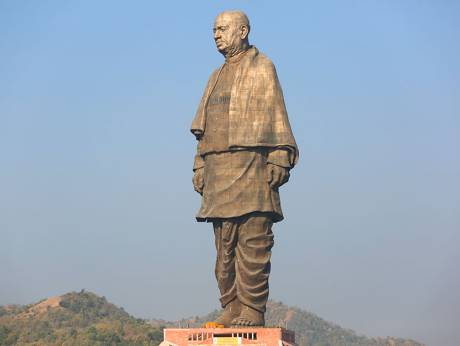
The Statue of Unity to valorise Sardar Patel — India’s first deputy prime minister, the ‘Iron Man’ who unified India — brings to mind two contrasting poems. Percy Bysshe Shelley’s ‘My name is Ozymandias, King of Kings; Look on my Works, ye Mighty, and despair!’ and Emma Lazarus’s ‘Give me your tired, your poor, your huddled masses yearning to breathe free’.
The Statue of Unity is four times as tall as the Statue of Liberty, but the Lady in the harbour is symbolically the taller structure for it speaks to our better nature. Tribal leader Chotu Vasava asks: “I am not against Sardar, but what is the use of the statue if the people on the land have to suffer and are moved from their homes? His words lack the cadence of Emma’s poem, but the starkness of the message is loud and clear — Vasava’s people face eviction and loss of livelihood, the very opposite of Liberty’s promise to the huddled masses.
While discussing the Statute of Unity, matters like the use of bronze plating from China and the whataboutery of Mayawati statues, are marginal. The appropriation, and the rewriting of history are at the heart of statue politics. The reprising of the Iron Man’s legacy, and the Hindu right’s visceral hatred of Jawaharlal Nehru is central to this debate. The idea that if Patel had been the country’s first prime minister instead of Nehru, the history of Independent India would have been dramatically better is of a piece that has been in the making for long. Under Modi, this narrative has simply got more intense. Co-opting icons from the freedom movement is another consistent pattern of the new rhetoric.
India was fortunate to have two outstanding men to steer the country as it approached its tryst with destiny. Both were groomed for high office by the wily Mahatma Gandhi who combined saintliness with hard-nosed realpolitik. Nehru with his public appeal and Patel the organiser par excellence were made for each other — the tempestuous philosopher prime minister and his dour, inscrutable and grand unifier who was his deputy, a man who could parse his words carefully and diplomatically to win over his opponents. Patel was a man of action, a deal-maker, a practitioner of the art of the deal rather than a man of ideas like his prime minister who frequently prevaricated. He was deputy only in name, for Patel was Nehru’s equal in more ways than one. There were similarities as well: Both were fiercely patriotic and conspicuous in their integrity and probity in public life. Historian Ramachandra Guha flags another interesting common likeness: Both had a daughter as their housekeeper, companion and chief confidante.
However, there was intense rivalry between the two and serious ideological differences and these cannot be papered over. There was the distinct possibility that both would part ways and it was Gandhi who swore them to work together. This fragile peace between the two was crafted just before Gandhi was assassinated and ironically the Mahatma’s death brought them together like never before.
It needs to be said that Patel would be the first to concede that much of what he achieved would not have been possible if Nehru was not India’s first prime minister.
Sadly, Patel passed away just two years after Gandhi’s death, but not before completing his life’s ambition — the integration of more than 500 princely states into a unitary state. And this task — the biggest gamble in history as per Guha — could not have been possible without Patel. It was the farsightedness of Gandhi that for this impossible mission, he chose Patel to stitch together this unnatural nation [Guha’s characterisation] called India.
For even the most ardent fan of Nehru would agree this painstaking job was well beyond the ken of the country’s first prime minister. He simply lacked the patience and the crafty machinations required to cajole, threaten and force this union to come about. Patel was ably assisted by many others in this mission impossible, but he provided the extraordinary leadership to create the union of states.
It needs to be also said that Patel would be the first to concede that much of what he achieved would not have been possible had Nehru not been India’s first prime minister. The two were a dream team and notwithstanding the deep cleavages in substance and style, there was abiding respect for each other.
Ambivalent on independence
The Hindu Right has lacked an iconic figure who could be held up as their mascot during India’s long struggle for freedom. Truth is they were ambivalent on the entire issue of independence. Appropriation and falsehoods provide the cover for this dilemma and Sardar Patel is a perfect cut-out for this purpose. His views were far to the Right of Nehru’s on Hindu extremism, Pakistan and economic policy.
A perfect foil to create myths and denigrate the Congress and Nehru in particular. Patel may have been more forgiving of Hindu Right’s views on minorities, but he was unforgiving of the climate of divisiveness they spawned and fanned. He had banned the Rashtriya Swyamsevak Sangh after Gandhi was assassinated and revoked it only after it agreed to be a volunteer organisation eschewing politics. A nation with the motto ‘Truth Alone Triumphs’ [Satyameva Jayate] needs to put to bed, untruths. Forever!
Ravi Menon is a Dubai-based writer, working on a series of essays on India and on a public service initiative called India Talks.




_resources1_16a31069e4e_small.jpg)







